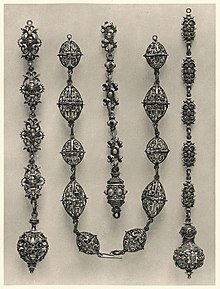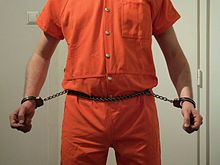Belly chain

The terms belly chain and hip chain denote , on the one hand, a piece of jewelry that is worn around the belly or hips , and on the other hand, chains for tying .
trinket
Belly chains are usually made of gold or silver . In addition to these purely metal chains, there are also cords on which pearls , shells or precious stones are strung. Furthermore, a metal chain or cord can also have different jewelry pendants.
Bondage
Belly chains for tying prisoners are particularly common in the USA and are mainly used when prisoners are to be tied up for a long period of time, for example during a transport or at court appointments. The reason for the use of such restraints is that prisoners have a relatively large amount of freedom of movement if the hands are only handcuffed in front of the body. As an alternative, the hands could be closed at the back, but this is uncomfortable to painful for the handcuffed person over a long period of time. As a milder alternative, the hands are fixed with a chain at stomach height.
There are essentially two types:
- One variant consists of a chain with handcuffs attached to the front or side. Belly chains with handcuffs attached centrally at the front are manufactured by Peerless as Model 7003, while the Peerless Model 7002 or Smith & Wesson Model 1800 has the handcuffs attached to the side with a short chain. In the CTS Thompson Model 7008, the handcuffs are also placed on the side, but in contrast to the models mentioned, the handcuffs are attached directly to the belly chain without a connecting chain, so that the prisoner's hands are fixed relatively close to the waist. Peerless also has a shackle model 7705, in which a connecting chain leads from the belly chain to a pair of ankle cuffs ; this further restricts the possibility of escape. When using this type of belly chain, the chain is first placed around the prisoner's belly and secured with a padlock behind the back. Then the handcuffs are closed and locked around the wrists. In the standard case, the prisoner's hands are fixed either in front of the body or on the side of the waist, thereby restricting freedom of movement. In special cases, the hands can also be crossed so that the left hand is placed in the cuff on the right waist and vice versa. A tie with the arms crossed in the end comes close to a straitjacket.
- Another variant consists of a chain with slightly larger links and a steel loop (called a martin link ) at one end. The chain is placed around the prisoner's stomach and the steel loop is put through a chain link. Then a pair of handcuffs is threaded through the loop and put on the prisoner. The leftover chain can be secured with a snap hook or a padlock. The belly chain can only be removed once the handcuffs have been removed. The advantage of this shackle is that no padlock is required to fix it. The length of the chain is also measured so that it fits around the belly of almost everyone. For transports with an increased risk, the belly chain can be combined with a handcuff safety lock such as the C & S Security Black box or the CTS Thompson Blue Box. This hard plastic box with a metal slider can be placed over the handcuffs so that the keyholes are covered. On the one hand, this prevents the prisoner from manipulating the keyholes in the handcuffs and, on the other hand, the freedom of movement is further restricted, as the handcuffs become rigid through the box.
Instead of chains, belts made of leather or nylon are also used. These have a metal ring on the front through which the handcuffs are put and then put on the prisoner. The belt is placed around the prisoner's waist and locked with a buckle, some of these bondage belts can also be secured with a lock. Such restraint belts are sometimes used in Europe for particularly dangerous prisoners.
In addition to official use, belly chains are also used in bondage .
See also
Web links
Individual evidence
- ^ Jewelry Glossary. (No longer available online.) JewelrySales.com, archived from the original on July 28, 2010 ; Retrieved on July 19, 2010 (English): "Belly chain is a piece of body jewelry that is worn around the waist." Info: The archive link was automatically inserted and not yet checked. Please check the original and archive link according to the instructions and then remove this notice.
- ↑ Enris: Enris - American Handcuff Co. - Handcuffs. In: www.handschellen.org. Retrieved October 26, 2016 .
- ↑ Safe Prisoner Transport . ( policemag.com [accessed October 26, 2016]).
- ↑ Collection 2. In: www.alexhandcuffs.com. Retrieved October 26, 2016 .
- ^ Guenter K .: Other fetters. In: www.atame.info. Retrieved October 26, 2016 .
- ^ Guenter K .: Other fetters. In: www.atame.info. Retrieved October 26, 2016 .
- ↑ Transport Belt with Handcuffs and Lockable Slots | Officer.com . In: Officer.com . ( officer.com [accessed November 14, 2016]).



